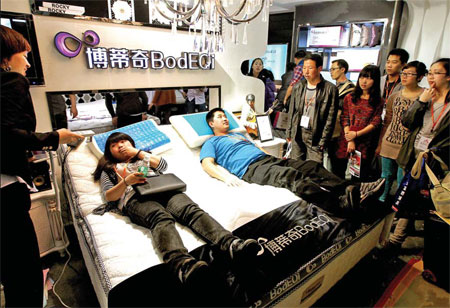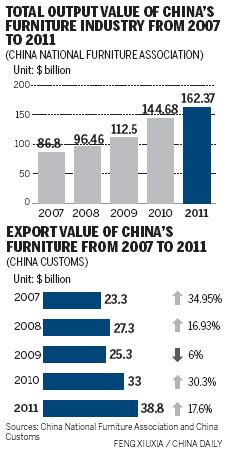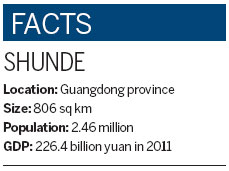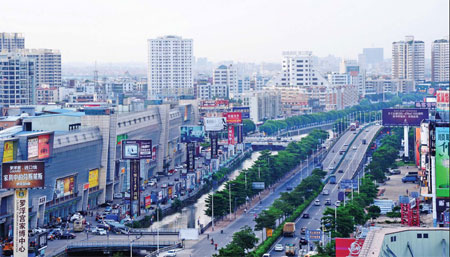Fitting place for fine furnishing
Updated: 2013-01-18 09:07
By Yang Yang (China Daily)
|
|||||||||||
|
Above: Louvre Furniture Exhibition Center in Lecong town, Shunde, covering 120,000 square meters by national highway 325. As one of the largest furniture sourcing centers in the country, it houses markets for both furniture and materials. Below: Visitors check out a high-tech mattress at the Qianjin Exhibition Center in Shunde, Guangdong province. |


Once the champion of the furniture industry, shunde is polishing its act to again outshine the competiton
Shunde, the hometown of kung fu screen idol Bruce Lee and other martial arts legends, has a fight on its hands. This district of Foshan in South China's Guangdong province is also known as the cradle of the country's furniture industry. Since the early 1980s, taking advantage of its proximity to Hong Kong, more than 2,600 furniture makers and 3,000 dealers have set up shop along national highway 325, which runs through the towns of Longjiang and Lecong in Shunde. Neighboring cities in the Pearl River Delta, such as Dongguan, took up the trend and the province became the main source of furniture for the domestic market and export. But that cradle has been rocked hard and taken some knocks over the years.
Guangdong furniture gradually lost its dominant position as the domestic market grew and economic woes hit overseas markets. In 2009, its Chinese market share dropped from 50 percent in 2007 to one-third, and today is less than 30 percent, says Qian Jiang, general manager of the Asian International Furniture Material Trading Center, a 2,740-hectare park in Shunde that houses 1,100 furniture businesses, the largest of its kind in the world.
In November, it was reported that several companies were debt-ridden. Some had shut down their factories.
"In our center, 20 percent of the shops were in the black, 30 percent broke even and 50 percent were in the red in 2012," says Qian.
Although the center's turnover in 2011 had been close to 30 billion yuan ($482 million; 360 million euros), growth rates across the industry in Shunde and Guangdong had slowed down considerably and it was no longer sitting comfortably.
This has been put down to the combined effects of the economic slowdown in the principal overseas markets of Europe and the United States, stricter regulation of the property market in China, higher labor and land costs in Guangdong, attractive policies from other regions forcing companies to relocate, and shortfalls in quality and design of furniture.
"Growth in Shunde has inevitably slowed down as a result of new policies and macroeconomic environment," Qian says.
"Another factor is that Shunde is facing more challenges from other fast-growing furniture manufacturing bases in China, such as Likou in Jiangsu province and Chengdu in Sichuan province."
Many small cities in those provinces have decided to develop their furniture industry in line with the national and regional governments' 12th five-year plans (2011-2015) and even for the following five years. Governments in those provinces and cities are making policies that are more favorable for this industry, Qian says, but those in Guangdong have not.

With regard to quality and design of products, Shunde also has had the chair pulled from beneath it by European furniture manufacturers, particularly in Italy and Germany.
"In terms of quantity, China is the world's largest furniture manufacturer, but compared with Italy, our products have much lower added value," says Hu Lingxiao, deputy manager of Shunde Empire Furniture, one of the largest shopping malls in the district, which saw sales growth drop from the double-digit figures of previous years to single-digit in 2012.
"If we want to catch up with Italy, we need to start with design, including the cultivation of our taste and education of designers, which I think will be a long process."
Now, in the spirit of its famous sons, Bruce Lee and fellow martial arts legends Wong Fei-hung and Ip Man, Shunde's furniture businesses are fighting back. They are working together, and with the improving local government craftsmanship, image and reputation.
In August, 30 leading Shunde furniture producers formed the Brand Union of Shunde Furniture to promote Shunde furniture and increase its competitive strength.
"Shunde doesn't lack good products but a united brand that will receive recognition by consumers," says Zhou Zhenyang, deputy director of the Shunde Furniture Association.
That move is aimed primarily at the domestic market, with Shunde furniture products seeking more market share in the second- and third-tier cities.
Internationally, for the export market, Riccardo Ribechi, business and regional area manager of one of Europe's prime furniture designers and manufacturers, Poltrona Frau Group in Italy, outlines the challenges Shunde faces.
"Chinese furniture has made a lot of progress over the years, but the gap is still very big," he says, citing his visit to 2012 Furniture Fair in Cologne, Germany, where he saw many Chinese furniture companies. "The quality in general is good enough, the difference is in design.
"The design of Chinese furniture is very simple and not really up to date. There is a lack of research in terms of design, new materials and technical solutions. It is difficult for me to mention a good example of Chinese furniture."
Qian, who as well as being general manager of Shunde's giant trading center is executive president of Shunde Furniture Design Institute, accepts the criticism up to a point.
"I think the general design level in Shunde lags 10 years behind that of Italy, but in certain projects, our level is comparable," he says.
Now, in a bid to reduce that gap, local governments in Shunde and Guangdong province are running various kinds of furniture design competitions, with prizes up to 100,000 yuan.
Yuan Zehong founded Yitong Design in Shunde two years ago and already enjoys annual growth of 40 to 50 percent in orders. Previously, he worked for several furniture companies after graduating from Shunde Polytechnic more than 10 years ago.
"It is more a case of technical problems than one of design," Yuan says of the challenges facing Chinese-made furniture. "Chinese people have their own tastes. Italian exhibitions can provide inspiration for us but we still need to cater to local consumers' needs.
"But as more Shunde furniture companies develop toward the high-end market, design becomes important."
Vollodis Furniture, one of the top 10 producers of beds and mattresses in China, saw its growth rate of revenue drop from 20 percent annually over the past five years to 15 percent in 2012. Its general manager, Zhou Zhenyang, says his company, which has a 12-strong design team among its 450 employees, is collaborating more with foreign and Chinese designers to improve the look and function of its products.
"Since I founded the company 15 years ago, we always have been trying to improve our design capability," he says. "We are also choosing excellent talents from top furniture design students in universities such as the Guangzhou Academy of Fine Arts."
Last year, Foshan Hong Qiao Furniture, one of China's largest office chair producers, invited Japanese designer Toshiyuki Kita to design its new office furniture.
"Design is the core competitive strength of our company. Since we founded the company 13 years ago, we have been designing new products based on our experience, and now we have a design team of 40 people," general manager Zuo Boliang says.
Besides design, the local government is also trying to promote the use of new materials.
"Promoting water-based paint is the most important job for 2013," says Qiao Xiaobin, director of Longjiang Economy Promotion Bureau.
"But, because of technical and cost problems, very few companies have adopted this environmentally friendly paint that will reduce pollution during production and pose less risk to human health."
The latest concepts in furniture making have also been introduced from Europe.
"When we visited furniture fairs in Europe, we saw LED lights were being used to improve furniture's function and also make life more colorful," Qian says.
In 2011, the output value of Shunde furniture hit nearly 100 billion yuan ($16 billion, 12 billion euros) and more than 52 percent was exported to the international market, according to Shunde Furniture Design Institute.
For China as a whole, the output volume of the furniture industry in the first 10 months of 2012 grew by only 5.15 percent, compared with 16 percent in 2011, the China National Furniture Association reports.
Last year, the output value for Guangdong province alone surpassed 300 billion yuan, of which about two-thirds was for the domestic market, up 10 percent compared with 2011. Exports grew by 2 percent, where it had averaged 6 percent over the previous five years.
yangyangs@chinadaily.com.cn
(China Daily 01/18/2013 page16)
Today's Top News
Police continue manhunt for 2nd bombing suspect
H7N9 flu transmission studied
8% growth predicted for Q2
Nuke reactor gets foreign contract
First couple on Time's list of most influential
'Green' awareness levels drop in Beijing
Palace Museum spruces up
Trading channels 'need to broaden'
Hot Topics
Lunar probe , China growth forecasts, Emission rules get tougher, China seen through 'colored lens', International board,
Editor's Picks

|

|

|

|

|

|






